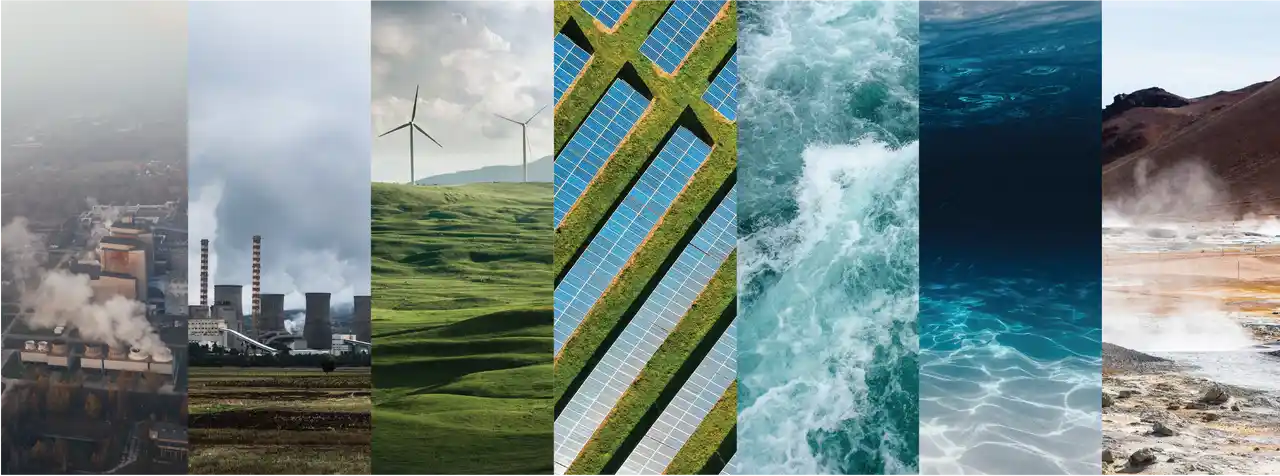
When it comes to generating energy we’re spoilt for choice.
You flip a light switch and electricity leaps to your service, you turn it off and it vanishes just as quickly. Given how reliant every facet of our lives is on electricity, we tend to forget both the long journey it takes to reach our homes and the array of options we have to generate it in the first place.
Over the course of any given day, the energy flowing into your home or business could come from a wide range of sources, yet regardless of their origin, all the watts mingle seamlessly, producing one constant stream of energy.
The harmony achieved in our power lines is a small wonder of physics, given the ingenious collection of ways we’ve devised to extract energy from the environment. In this article, we’ll be looking at the following types of energy: fossil fuels & biomass, nuclear, solar, wind, wave & tidal, ocean thermal, and geothermal.
Terms like ‘fossil fuels’ and ‘renewable energy’ sprinkle our conversations, and many people think that there exists a stark dichotomy between the two; that it’s an all-or-nothing choice.
In reality, energy sources inhabit several spectrums (e.g. more to less carbon-intensive, or more to less intermittent), and any viable energy roadmap for the 21st century will need to incorporate many of them since each has its own set of advantages and drawbacks. Let’s take a closer look at these different types.
Fossil Fuels & Biomass
This is the category we are most familiar with, encompassing the big three legacy sources of oil, gas, and coal, alongside more marginal options like methane, ethanol, and biomass (wood, algae, peat, etc.) Thermal generation involves the combustion of energy-rich matter, with the resulting heat being used to energize air, water, or other fluids, which impart energy on mechanical devices.
In order to turn the energy in oil and gas into something useful, we have to change the chemical energy of fossil fuels into thermal energy (heat); which in turn allows steam to be created and act on pistons and turbines, creating mechanical energy, which is then either used directly or is converted into electrical energy with the use of electromagnets (due to friction).
Nuclear energy
In terms of sheer generating power, nothing beats nuclear, which can provide gigawatts worth of electricity from relatively little fuel in facilities with small footprints (both in terms of square footage and carbon emissions). Nuclear plants harness the heat generated from radioactive decay, as atomically unstable elements transform into more stable forms.
Nuclear plants capture this heat and use it to convert water into steam, thereby powering generators and creating electrical energy.
Solar Energy
The amount of solar energy hitting the planet every day dwarfs our annual, global energy needs, but the problem is managing to efficiently capture and store this energy.
When particles from the sun called photons hit solar panels, they dislodge electrons in the top layer of silicon cells, these electrons can then be harnessed for our needs, before returning to the second layer and reattaching themselves to the silicon atoms located there.
This means that there are no moving parts in a solar system, which reduces wear and tear as well as the potential for mechanical failure. A second, more roundabout way to produce energy from solar power is the use of mirror arrays to create focused beams of light, much like a magnifying glass, in order to boil water and create steam.
The scalability of solar is a key selling point, as it allows for the construction of both large projects servicing the grid, as well as microgrid solutions that target a single office block or suburban home. From paneled roofs to large solar arrays, to floating solar farms, solar panels can be installed in many places.
Wind Energy
Like solar, wind energy utilizes naturally occurring forces to cut out the need for fuel sources. While less scalable than solar energy, wind energy generators come in many sizes.
By harnessing the kinetic force of the wind via rotor blades, wind turbines can convert this kinetic energy first into mechanical energy (via the turning of generators) and then into electrical energy for distribution in the grid.
As with solar, wind power suffers from variability (inconsistent generation capacity due to variable wind speeds), so it needs to act as a complement to more reliable sources, and/or be linked to storage solutions in order to capture wind energy for later use. Wind farms operate both on land and offshore, where there are more consistent winds and fewer landscape features blocking wind currents.
Wave & Tidal Energy
The motion of the tides and currents can be used to generate power by harnessing the kinetic energy of the world’s oceans to drive underwater turbines in a way similar to gravity-fed hydropower from dams.
Compared to other renewable energy sources, tidal energy offers extremely predictable and regular power production, so it offers a potential alternative to more carbon-intensive baseline generation sources. Similarly, wave power generators used the regular oscillation of the waves to produce energy, which can then be transmitted to land via undersea cables.
Ocean Thermal Energy
An emerging energy source is ocean thermal energy, which uses the temperature differential of seawater at different depths to produce electricity using a heat engine (which uses heat to expand gases and thus exert mechanical force) that converts heat to kinetic and ultimately electrical energy.
While still in its infancy, ocean thermal energy can also be used to provide baseline generation as it lacks the variability of other renewable energy sources.
Geothermal Energy
Geothermal energy is similar to the concept of ocean thermal energy mentioned above, as it also utilizes the temperature gradients between different regions, in this case, the differences at different depths in the earth.
Geothermal energy can use heat from shallower depths for everyday uses like heating your home (to this end, some old oil and gas well can be repurposed), whereas deeper drilling is required to capture sufficient heat to generate large amounts of electricity Geothermal energy is also very stable, which makes it able to provide baseline generation.




